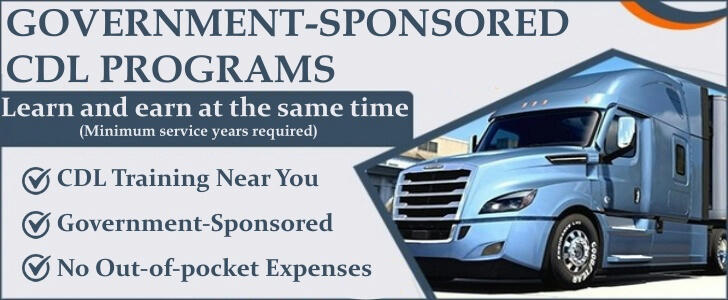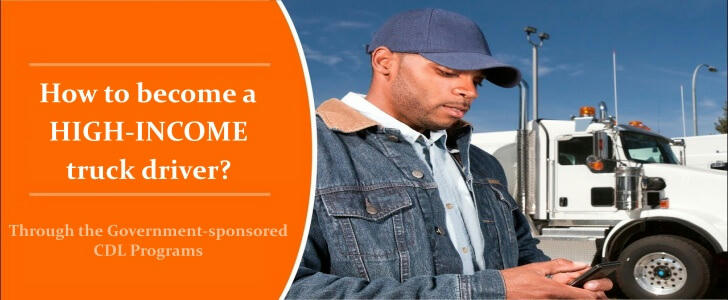【Government-supported CDL Programs】 CDL Commercial Driver License Training Programs
Many choose CDL Training Programs to balance career goals and financial needs. Government-supported CDL Programs offer the opportunity to get paid during training without having to pay any tuition upfront.
Government-supported CDL Programs lets you earn while you learn.🚛

Benefits of participating in the CDL Training Programs
There is a growing demand for truck and commercial vehicle drivers in society, and it makes sense that many people choose this path. Compared with going to college or participating in other vocational training, Government-supported CDL Programs is more time-saving, more practical, and easier to find a job. There are several obvious advantages:
💵Government-supported CDL Programs
Most training costs can be supported by the government through the Workforce Innovation and Opportunity Act (WIOA) and state job subsidy programs—zero upfront costs and no loans required. Many programs provide income support during training, and some employer-partnered programs even use an "earn while you learn" apprenticeship model with a certain period of service.
📚Short training time, you can be on the road in a few weeks
Unlike traditional courses, CDL Training Programs usually only takes 3 to 8 weeks to complete the written test, road test, and obtain a commercial driver's license. Moreover, most programs provide a one-stop service of practical exercises + certification, with a short training cycle but high gold content.
🛡️High Starting Salary, Comprehensive Benefits
Entry-level CDL drivers earn an average annual salary of $40,000–$50,000, with some regions offering bonuses or night shift premiums that can push earnings to $70,000+. More experience means higher pay. Most employers provide health insurance, retirement plans, and paid time off.
🚛High-demand industries: many positions and large gaps
The logistics system in the United States relies heavily on truck transportation, and there is a long-term shortage of truck drivers. According to the American Trucking Association (ATA), the driver gap will exceed 160,000 by 2025.
👉 means: once you get your license, you have the opportunity to get a job immediately.
Who Qualifies?
Government-supported CDL Programs are open to applicants of all ages and career backgrounds:
| Category | Description |
|---|---|
| Young Adults (18–25) | Start a career early, avoid student debt, and earn immediate income. |
| Career Changers (25–45) | Upgrade skills for higher-paying jobs through faster job placement. |
| Adults (45+) | Transition to a reliable, flexible career with stable pay and benefits. |
Note: Interstate driving requires applicants to be at least 21 years old, hold a valid driver's license, and pass a DOT medical exam.
How to Apply for CDL Training Programs?
1. Find Local Programs
Search for Government-supported CDL Programs near you—many employers sponsor tuition.
2. Confirm Eligibility
Age 18+ (21+ for interstate routes).
Valid standard driver's license.
Passing a DOT physical exam.
3. Complete Training & Licensing
Finish the course, pass the CDL skills test, and obtain your commercial license.
4. Start Working & Earning
Receive job placement support and begin your driving career immediately after certification.
Nearby Government-supported CDL Programs
The following areas currently host a high number of Government-supported CDL Programs. Apply based on your location:
Texas: Roadmaster and other schools, some partnered with the Texas Workforce Commission.
California: Los Angeles, Sacramento—search via CalJOBS.
Florida: Tampa, Orlando, and other cities offer Training Programs.
Illinois: Chicago's WIOA program supports unemployed/career changers.
Ohio: Columbus and others—apply through OhioMeansJobs.
(Other states: Check local job centers or WIOA initiatives.)

What does the CDL Training Programs cover?
Vehicle Safety & Basic Maintenance: Daily truck inspections, brake/light/tire checks.
Traffic Laws & Transport Regulations: FMCSA (Federal Motor Carrier Safety Administration) rules.
Maneuvering Large Vehicles: Parking, lane changes, and turns in tight spaces.
Emergency Repairs: Handling roadside breakdowns.
Cargo Securement: Safe loading and transport practices.
Navigation & Route Planning: Optimizing drive times and fuel efficiency.
Success Stories
👨 Marcus (Age 42, Former Warehouse Worker from Missouri)
I worked in a warehouse for over a decade for very low pay and with a bad back. Then I joined the CDL program and got government support. After six weeks of training, I got a job as a regional driver. I go home every night to be with my kids and now make nearly $70,000 a year. It changed my life.
👩 Trina (Age 36, Mother of Two from Georgia)
"I was a full-time mom trying to get back into the workforce, but nothing stuck. Then I found a CDL Programs that offered night classes and childcare help. I finished the course and started working in local food delivery. The hours fit my family schedule, the pay is steady, and I finally have my own income. It feels so good to be independent again."
👨 Chris (Age 28, Former Restaurant Worker from Arizona)
"I lost my restaurant job during the pandemic and things were tough. A friend told me about a company that offered CDL Training Programs, so I gave it a shot. I earned my license in four weeks and started driving long-haul. It's hard work, but I’m making double what I used to and finally saving for a house. Next up — getting my Hazmat endorsement for even better pay."
Government-supported CDL programs offer you a great opportunity to start a career as a truck driver that is in high demand and low entry—no degree or experience required. Don't hesitate—start your rewarding truck driving career today with a CDL program near you!
